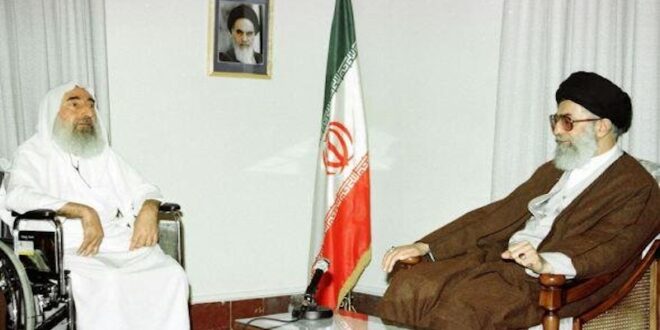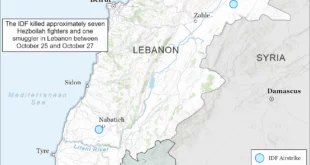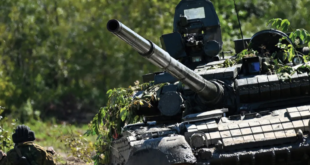In the early morning of Saturday, October 7, a series of coordinated attacks on Israel by the radical Palestinian movement Hamas followed. The “Al-Aqsa Storm” began with the firing of about 3,000 rockets and the infantry-mechanized incursion of militants into the territory of southern Israel.
The Israeli security services completely failed, so Hamas militants quickly crossed the border between the Gaza Strip and Israel and began to kill civilians in Israeli kibbutz and attack Israeli military bases. In one day, Hamas militants killed more than 350 Israeli soldiers and policemen and more than a thousand civilians. The attack was particularly successful because it was the Jewish holiday of Simhat Torah and a music festival was taking place near Re’im. About 200 Israelis were taken to the Gaza Strip as hostages, among them children. It was one of the most terrible days in Israeli history and the greatest suffering of Jews after World War II. Over 1,400 civilians were killed in a few days. It can rightly be said that October 7, 2023 is Israel’s Pearl Harbor followed by the horrendous Israel-Hamas war that is still going on. An ongoing war could ignite the Middle East. (For Part II click here)
In order to better understand the current conflicts in the Holy Land, the origin and rise of Hamas should be considered. Translated from Arabic, Hamas means the Arab Resistance Movement. It is a classic radical Sunni Islamist movement that is present in the Palestinian territories – the Gaza Strip and to a lesser extent in the West Bank of the Jordan River. Hamas is the most powerful Palestinian political organization after the Palestine Liberation Organization (PLO).
After the intra-Palestinian conflicts, Hamas has been in control of the Gaza Strip since 2007, where it established a one-party state based on radical Islamism. The main element that distinguishes Hamas from the PLO and its strongest party, Fatah, is Islamist radicalism. While the PLO is committed to democratic negotiations with the Israelis to finally resolve the Palestinian issue, Hamas rejects negotiations and wants to establish a Palestinian state by force. Although the radicalism of the movement has in theory been reduced over time, the latest events show that it is only a matter of tactical moves.
Circumstances of the Israeli occupation of Gaza
In the Six-Day War of 1967, also called the Third Israeli-Arab War, Israel occupied the entire West Bank of the Jordan River and the Gaza Strip – areas designated for a Palestinian state under the 1947 UN resolution on the partition of Palestine. In that war, the Israelis also occupied the Golan Heights and the Sinai Peninsula. It was a decisive event in the history of the Israeli-Palestinian conflict, after which nothing will ever be the same. This was followed by Israeli occupation or rule (depending on the point of view) over the Palestinian territories. The circumstances were specific and particularly difficult in the Gaza Strip. Namely, it is an area with an area of 365 square kilometers. The area is 41 km long and 6 to 12 km wide on average. It is surrounded by Israel, the Mediterranean Sea and Egypt. It is a Palestinian enclave that is completely cut off from the West Bank.
After the First Israeli-Arab War in 1949, the Gaza Strip was occupied by Egypt and numerous Palestinian refugees arrived there from the areas occupied by the Israeli army. In 1967, the Gaza Strip itself was occupied by the Israelis in a violent invasion. The Israeli occupation began. In 1987, the Gaza Strip had the highest population density in the world – 1,600 inhabitants per square kilometer.
Israeli historian Benny Morris in the book “Righteous Victims: A History of the Zionist-Arab Conflict, 1881-1999” wrote: “One researcher compared the Gaza Strip to a pressure cooker consisting of overcrowding, poverty, hatred, violence, poor sanitation, anger, frustration, drugs and crime. Many homes in the refugee camps did not have running water, sewage flowed through the streets. About half of the population lived in inhumane conditions. In 1986-1987 the increase in new births was two and a half times the increase in the number of apartments and houses.”
In the Gaza Strip, per capita income rose from $80 in 1967 to $1,700 in the early 1980s. The number of cars in the territories under the occupation of Israel increased tenfold in those years, the number of telephone connections increased threefold. In 1968, only 18% of households in Gaza had electricity, in 1981 this number increased to 89%. These were positive numbers, but the Israeli occupation, unfortunately, brought a lot of bad things.
Haaretz journalists Ze’ev Schiff and Ehud Ya’ari described Israel’s policy towards the Gaza Strip as pure despotism, greed and selfishness. Gaza and the West Bank were markets for Israeli goods. The population in the occupied territories was obliged to request permits for movement, import of raw materials, entry of money and construction materials. Residents in the occupied territories could hardly establish companies. The occupied territories were a large reservoir of cheap labor. Most of the Palestinians did the hardest physical jobs for less wages than the few Israelis who would agree to do those jobs. In addition to all this, the Gaza Strip and the West Bank were under firm Israeli military occupation.
The Rise of the Palestinian Islamic Jihad
The Palestinian struggle for national liberation was led by the Palestine Liberation Organization, but after it had to leave Lebanon for Tunisia in 1982, its influence and power seemed to weaken. On the other hand, new role models were emerging. The Shiite militia Hezbollah in southern Lebanon was inflicting heavy losses on the Israeli army. In the fall of 1987, the Palestinian Islamic Jihad (PIJ) carried out subversive actions against the Israeli authorities in the Gaza Strip.
In August, a military police captain was killed in the center of Gaza, grenades were thrown at the army headquarters and vehicles of the Israeli services, and two Arab collaborators of the Israeli security services were killed. On October 10, in honor of its slain members, PIJ called residents for a one-day strike that turned into large demonstrations and an attack on a police station in Gaza. About twenty attackers on the station were wounded. The Israeli authorities decided to demolish the houses of four PIJ militants.
The occupied territory of Gaza will never be the same after those violent events, as Benny Morris rightly observes. Militants of the Palestinian Islamic Jihad declared the day of the burning of the houses as the day of the beginning of the jihad that will take place over time. The ground has been prepared for the rise of Palestinian Islamist radicalism.
The gradual emergence of Hamas
Hamas was founded by Sheikh Ahmed Yassin, a Palestinian imam who became an activist in local branches of the Muslim Brotherhood after devoting his early life to studying Islam in Cairo. From the late 1960s, Yassin preached and did humanitarian work in the West Bank and Gaza, which Israel captured after the Six-Day War in 1967. Hamas was created as a branch of the Muslim Brotherhood, which was based in Egypt.
Palestinians like Sheikh Yassin, who were sympathetic to the aims of the Muslim Brotherhood, became involved in charity and social work in the Palestinian refugee camps. Yassin founded the future Hamas in Gaza in 1973, but then under the name Mujama al-Islamiya (Islamic Center). Five years later, the organization was registered in Israel. Although the organization was recognized at the moment, in a few hours its license to work was withdrawn, and in 1979 it was finally registered as a charitable organization. Under the umbrella of the Islamic Center and together with other Muslim humanitarian organizations, Hamas has built an impressive infrastructure.
More precisely, during the 1970s, activists associated with the Muslim Brotherhood established a network of charities, hospitals, schools, social welfare societies, youth clubs, etc. They made special efforts to improve the lives of refugees in Palestinian refugee camps. In Gaza, they were active in many mosques, while their activities in the West Bank were mostly limited to universities. The activities of the Islamic Center were generally non-violent, but smaller groups in the occupied territories began calling for jihad (holy war) against Israel.
A traffic accident in which an Israeli army truck crashed into a car at a Gaza checkpoint, killing four Palestinian workers, was the trigger for the First Intifada, which began on December 8, 1987. The Intifada is the name given to the Palestinian uprising against the Israeli occupation of the West Bank, Gaza and East Jerusalem. While thousands of people in the streets of the West Bank and Gaza took to the streets and attacked Israeli military and civilian facilities, a group of people met in Gaza. Between December 9 and 10, seven people met at Ahmed Yassin’s house. Along with Imam Yassin, there were a doctor, a pharmacist, a professor, an engineer and two teachers. That night, these people will establish Hamas – the Islamic resistance movement as a kind of paramilitary branch of the Muslim Brotherhood in Palestine, which was a great historical event.
Hamas stands for the words “ardor”, “strength” and “courage” in Arabic. The movement emerged from the Muslim Brotherhood and the religious factions of the PLO. Yassin became the spiritual leader of the organization. At that time, Hamas sought to create an alternative to the secular PLO and operate on the principles of political Islam. Also, Hamas’ goal was to weaken other Islamist Palestinian movements such as the Palestinian Islamic Jihad (PIJ). Only after that came resistance to Israeli occupation. The new organization quickly gained a large following. With the creation of Hamas in 1987, the Islamists in Palestine got the most powerful organization.
Hamas charter
In December 1987, the first Hamas leaflet appeared in which the word intifada was written and the goals of the rebellion were set in it: the destruction of the Zionist enemy, opposition to the peace process, the conversion of Arab states to the Islamic path and their involvement in the Israeli-Palestinian conflict. In January 1988, the first leaflet with the abbreviation Hamas appeared. That was the first time the Hamas charter was made public.
The document defines the Palestinian issue as a religious issue. In its 36 articles, the charter refers to canonical early Islamic texts including the Koran and hadiths in which Islam’s relationship to Judaism and Christianity is clearly defined. It is an unquestionably anti-Semitic text. The charter calls for the destruction of Israel and the establishment of Sharia rule in historic Palestine from the Jordan River to the Mediterranean Sea. It is stated that Palestine is a Muslim country that can never be given over to non-Muslims and that the goal of waging a holy war, jihad, is to wrest control of Palestine from Israel, which is the religious duty of Palestinian Muslims. In the charter it is written: “The Day of Judgment will not come until the Muslims fight against the Jews and kill them.”
This attitude of Hamas brought it into conflict with the PLO, which recognized Israel’s right to exist that year. At that time, few Israeli politicians and intelligence officers understood the importance of the Hamas charter, which actually gave a new dimension to the Israeli-Palestinian conflict. Since the charter put religion in the foreground, it viewed the conflict between the two nations primarily as a religious conflict between Islam and Judaism, that is, Muslims and Jews.
Israel’s covert support for Hamas
American and Israeli sources have revealed that most of Hamas’s initial funding came from wealthy Arab states, but directly and indirectly from Israel, although the Israeli government has not produced any concrete evidence that it ever sent money to Hamas. Initially, the Israeli government did not mind the emergence of another center of power in the occupied territories that would shake the dominance of the Palestine Liberation Organization, which Israel considered the most dangerous organization. One former CIA official said that Israel’s support for Hamas “was a direct attempt to divide and dilute support for the strong, secular PLO by using a competing religious alternative.”
In accordance with the policy “the enemy of my enemy is my friend”, the Israeli authorities believed that the strengthening of the Islamists could only go to the detriment of the PLO. The Israeli security services did not miss the fact that already in the mid-1980s, the society led by Sheikh Yassin began to prepare for war and terrorist actions. In June 1984, in one of Yassin’s mosques, Israeli security services discovered caches of rifles and pistols. Yassin was arrested and sentenced to 13 years in prison, but in the exchange of prisoners between the PLO and the Israel Defense Forces (IDF) he was released from prison the following year in 1985. Until Hamas became actively involved in the First Intifada, the Israeli security services’ first target was are members of the PLO.
The four stages of Hamas’ strategy
Sheikh Yassin explained in an interview that Hamas’s strategy had four stages. The first stage was the construction of institutions such as kindergartens and charities that would attract young and old. The second stage was about strengthening support for Hamas in every household in Gaza. This was to be achieved through the exemplary life of the organization’s members in accordance with Sharia law.
Palestinian historian Yezid Sayigh writes in the book “Armed Struggle and the Search for a State: The Palestinian National Movement, 1949-1993”, “Hamas was an offshoot of the Muslim Brotherhood society in Palestine. It was part of a movement founded in Egypt in 1928. Like its Arab counterparts, the Palestinian branch took the Arab defeat of 1967 with a heavy heart, seeing it as evidence of the failure of secular socialism and nationalism. His representative in Gaza was Sheikh Ahmed Yassin, a refugee born in 1936 who became a preacher after poverty and an accident that crippled him prevented him from attending college. He allegedly saw the humiliation of the Egyptian army in the Six Day War as revenge for the execution of Sayyid Qutb in 1966 (a leading member of the Muslim Brotherhood in Egypt who was executed by the Egyptian authorities for planning the assassination of President Gamal Abdel Nasser). The followers of the society preached strict adherence to Islam, believing that piety, good family upbringing, uncorruption by Western values and Islamic consciousness are condicio sine qua non for resistance to Israel.
The third stage involved armed struggle. Armed struggle meant any form of attack, even terrorist action, “anything that,” as Yassin declared, “gives Israelis sleepless nights.” Yassin often said that under the banner of Islam, the Crusaders were driven out of Palestine. Hamas has been preparing for armed struggle for a long time. In 1986, Yassin founded the intelligence service of the Majdh movement. The fourth stage was the elevation of Hamas from local Palestinian affairs and the realization of dialogue with Arab and Islamic states. At the end of the day, for Hamas, a Palestinian state is not the end goal, but only a step towards the creation of a large Islamic state in the Middle East.
Differences between the PLO and Hamas
Hamas operated independently of other Palestinian organizations. He gained sympathy mostly through preaching in mosques and giving humanitarian aid to the poor. Unlike the PLO, which behaved corruptly in the 1970s and 1980s, and later since 1994 after the establishment of the Palestinian Authority, the representatives of Hamas were honest, cared for the needy and tried to help them, thus gaining the sympathy of the Palestinian population. An exemplary life according to Islam and an uncompromising attitude towards Israel were factors that attracted the Palestinian and wider Arab masses to Hamas.
The PLO and Hamas were at odds from the beginning. The PLO was a secular nationalist organization in which there were also openly left-wing movements such as the Popular Front for the Liberation of Palestine, which were a thorn in the side of the Islamists. On the other hand, Hamas was a religious organization. The PLO believed that a Palestinian state should be achieved through negotiations with Israel, while Hamas believed that the creation of a Palestinian state should come through armed struggle after the spiritual and ideological renewal of the Palestinian people. Given the differences, hostility quickly began to build between Hamas and the secular Palestinian political organizations led by the PLO.
The first clashes with the Israelis
In March 1988, Hamas carried out its first armed action. Militans set up an ambush in which an Israeli engineer who worked for the water company was wounded. Increasingly violent attacks by Hamas on Israeli government civilian and military targets prompted Israel to arrest many of its leaders in 1989, including founder Sheikh Ahmed Yassin. Hamas was banned in Israel. That year, Yassin was sentenced to life in prison for allegedly ordering the murders of Palestinians who collaborated with the Israeli authorities. In those years, Hamas was reorganized to strengthen its command structure and sent its main leaders abroad to be out of Israel’s reach, mostly to Jordan and the United States.
In Amman, Jordan, a political bureau (politburo) was established as the supreme body of the movement, which, among other things, takes care of collecting financial resources. Its leader was Khaled Mashal who was elected in 1996. The armed wing of the movement was also reorganized – the Izz ad-Din al-Qassam Brigades.
In 1997, Yassin was released from an Israeli prison as part of a deal with Jordan following a failed Mossad assassination attempt on Mashal in Jordan. Yassin was released in an exchange with two Mossad agents arrested by Jordanian authorities, on the condition that he refrain from continuing to call for suicide bombings against Israel. Jordan expelled Hamas leaders from Amman in 1999, accusing them of using their Jordanian offices as a command post for military activities in Palestine. In 2001, the Hamas politburo established a new headquarters in Damascus, Syria.
 Eurasia Press & News
Eurasia Press & News




